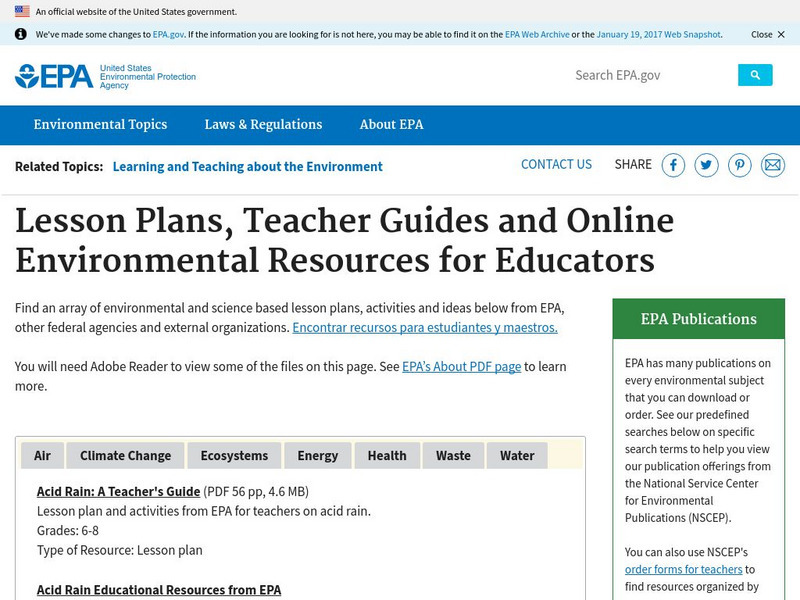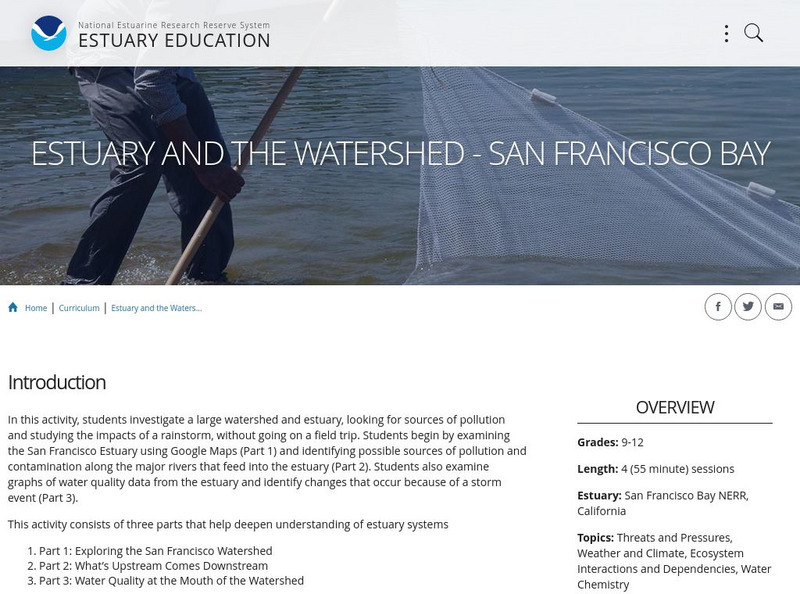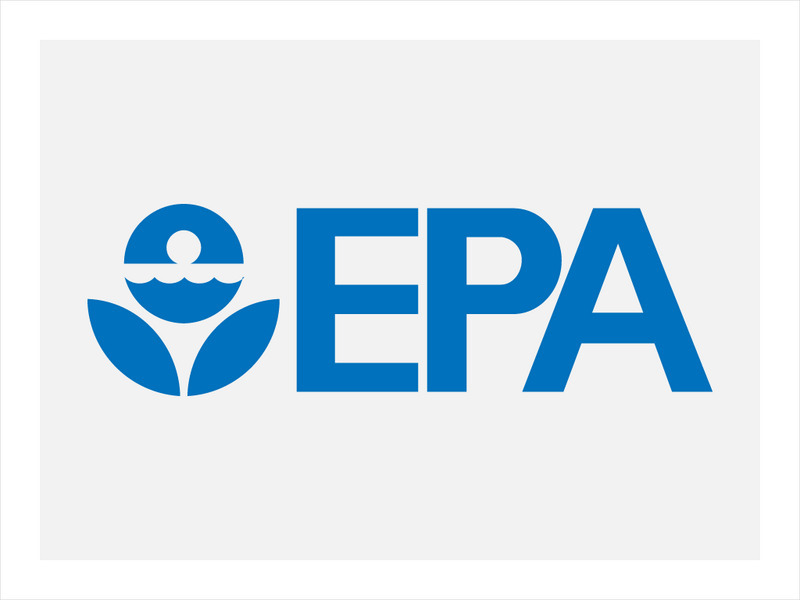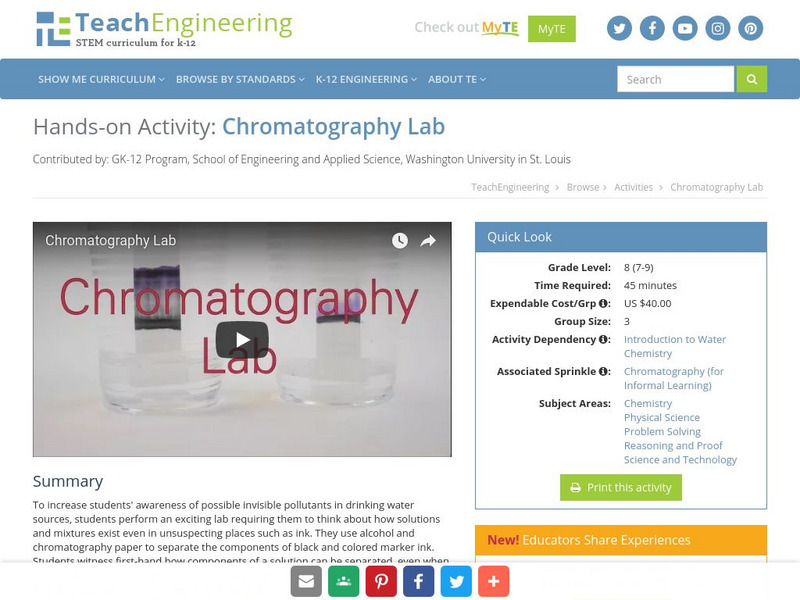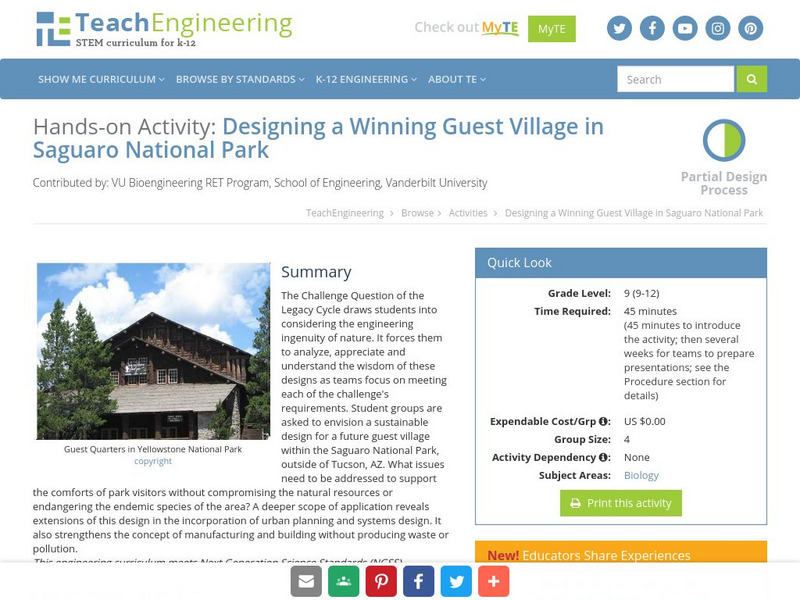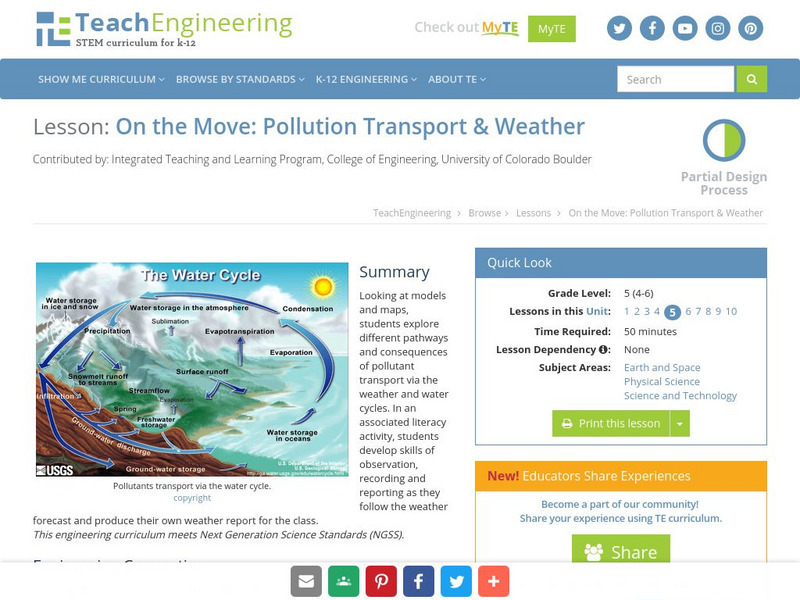Hi, what do you want to do?
Other
Coalition of Oregon School Administrators (Cosa): Microbeads, Mega Problem [Pdf]
A textbook activity where students work in teams to design a device or technique that will prevent plastic microbeads from entering local lakes and streams. They will use the engineering process to design a solution and then present...
TeachEngineering
Teach Engineering: Environment
Through 10 lessons and more than 20 hands-on activities, students are introduced to the concept of an environment and the many interactions within it. As they learn about natural and human-made environments, as well as renewable and...
US Environmental Protection Agency
Epa: Lesson Plans, Teacher Guides and Online Resources for Educators
Find an array of environmental and science-based lesson plans, activities and ideas from the EPA, other federal agencies, and external organizations.
NOAA
Noaa: Estuaries 101 Curriculum: Estuary and the Watershed San Francisco Bay
In this activity, students investigate a large watershed, look for sources of pollution in the watershed, and study the impacts of a rain storm on a watershed and estuary, without going on a field trip. Students investigate the nature of...
Other
Serdp: Managing Contaminated Sediments
This resource is from the Strategic Environmental Research and Development Program (SERDP), an environmental research arm of the Department of Defense. It explains how sediment contamination has affected DoD facilities and what is being...
TeachEngineering
Teach Engineering: What's Down the Well?
This activity looks at physical models of groundwater and how environmental engineers determine possible sites for drinking water wells. During this activity, students will create their own groundwater well model using a coffee can and...
TeachEngineering
Teach Engineering: Stream Consciousness
During this activity, students will learn how environmental engineers monitor water quality in resource use and design. They will employ environmental indicators to assess the water quality of a nearby stream. Students will make general...
US Environmental Protection Agency
Epa: The Spirit of the First Earth Day
This article is an in-depth description of the first Earth Day, and includes the impact the demonstration had on the environmental movement.
TeachEngineering
Teach Engineering: Microbes Know How to Work!
Students design systems that use microbes to break down a water pollutant (in this case, sugar). They explore how temperature affects the rate of pollutant decomposition.
Science Education Resource Center at Carleton College
Serc: Investigate Effects of an Oil Spill
This lab is designed so that students will understand the effects of oil spills on plants, animals, and the environment and investigate clean up methods through a simulated oil spill. They will understand the risks associated with...
TeachEngineering
Teach Engineering: Straining Out the Dirt
In this activity, students build a water filter with activated carbon, cotton and other materials to remove chocolate powder from water.
American Geosciences Institute
American Geosciences Institute: Earth Science Week: Freddy the Fish
Explore how pollution can affect natural organisms and habitats.
The Franklin Institute
The Franklin Institute Online: Slick Sea Spills
Use this site to promote environmental awareness in your classroom with this lesson on the effects of oil spills on water habitats.
Better Planet Productions
Earth Care: Now You're in Trouble
For this activity, Grade Two students build a classroom maze and investigate water drainage, learning about the urban sewage system in the process and why people need to be more mindful of what goes into it.
TeachEngineering
Teach Engineering: Chromatography Lab
To increase students' awareness of possible invisible pollutants in drinking water sources, students perform an exciting lab requiring them to think about how solutions and mixtures exist even in unsuspecting places such as ink. They use...
TeachEngineering
Teach Engineering: Designing a Winning Guest Village in the Saguaro National Park
The Challenge Question of the Legacy Cycle draws the student into considering the engineering ingenuity of nature. It will force him to analyze, appreciate and understand the wisdom of these designs as the student team focuses on meeting...
TeachEngineering
Teach Engineering: On the Move
Looking at models and maps, students explore different pathways and consequences of pollutant transport via the weather and water cycles. In an associated literacy activity, students develop skills of observation, recording and reporting...
American Geosciences Institute
American Geosciences Institute: Earth Science Week: Hands on Experiments to Test for Acid Mine Drainage
Fifteen short experiments which test acid mine damage to the streams, rivers, and creek ecosystems surrounding it.
University Corporation for Atmospheric Research
Ucar: Learn: The Greenhouse Effect
A detailed overview of the greenhouse effect, with explanations about Earth's atmosphere gases referred to as greenhouse gases, and the factors that influence the heat-trapping ability of a greenhouse. All information is reinforced...
Science Education Resource Center at Carleton College
Serc: Can We Revive Lake Erie's "Dead Zone?"
This Ohio Sea Grant website features a WebQuest-like activity that explores the development of a dead zone, an oxygen-deprived area where there is no life, in Lake Erie. The activity aims to teach learners about the processes that...
US National Archives
Docsteach: Birth of the Environmental Protection Agency (Epa)
By the late 1960s, issues of unchecked land development, urban decay, and air, noise, and water pollution came to Americans' attention. In November 1971, the newly created Environmental Protection Agency (EPA) announced a large-scale...
Other
Population Education: Homepage
Population Education provides teacher training and a variety of teacher tools to help educators on population concepts such as population growth, overpopulation, our effect on the environment, and related resources.
National Geographic
National Geographic: Sea Turtles and the Gulf of Mexico Oil Spill
After researching and comparing five species of sea turtles, students look at how they were affected by the Gulf of Mexico oil spill. Then they learn about efforts to relocate wildlife after an environmental disaster such as this, and...
TeachEngineering
Teach Engineering: Oil Spill
This lesson will allow learners to explore an important role of environmental engineers: cleaning the environment. Students will learn details about the Exxon Valdez oil spill, which was one of the most publicized and studied...





![Coalition of Oregon School Administrators (Cosa): Microbeads, Mega Problem [Pdf] Activity Coalition of Oregon School Administrators (Cosa): Microbeads, Mega Problem [Pdf] Activity](https://static.lp.lexp.cloud/images/attachment_defaults/resource/large/FPO-knovation.png)

